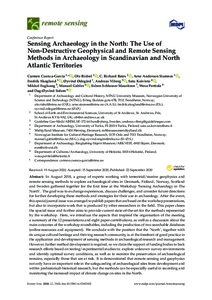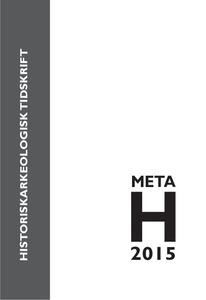Towards responsible archaeology : A critical look at the literature and public discourse surrounding two controversial burials
Albieri, Clarissa (2025-05-08)
Towards responsible archaeology : A critical look at the literature and public discourse surrounding two controversial burials
Albieri, Clarissa
(08.05.2025)
Julkaisu on tekijänoikeussäännösten alainen. Teosta voi lukea ja tulostaa henkilökohtaista käyttöä varten. Käyttö kaupallisiin tarkoituksiin on kielletty.
avoin
Julkaisun pysyvä osoite on:
https://urn.fi/URN:NBN:fi-fe2025051341362
https://urn.fi/URN:NBN:fi-fe2025051341362
Tiivistelmä
What can grave goods and bones truly tell us about the identity of those whose voices have been lost to time? What do archaeologists owe to these individuals, and to today’s public?
When grave Bj. 581 was excavated in Birka, Sweden, in the late 19th century, its occupant was assumed to have been a skilled, high-ranking male Viking warrior. In 2017, a team of researchers led by Hedenstierna-Jonson conducted an osteological analysis on the remains collected from Bj. 581, and found them to have belonged to an individual who was biologically female. In 1968, when the Suontaka burial, in Finland, was excavated, archaeologists were baffled to find two swords (one hiltless) next to a skeleton donning feminine clothes and jewelry, thus assuming them to be a woman. In 2022, Moilanen et al. published a paper in which they concluded that the individual buried at Suontaka had XXY chromosomes (Klinefelter syndrome), and that the arrange of grave goods can be interpreted as indicative of a gender presentation outside the male-female binary. Both articles have since been at the center of critiques, by other academics as well as by the public, and have been accused of “rewriting history” and applying contemporary ideologies to the past.
In the present literature review, the fields of gender archaeology and public archaeology lay the foundations upon which both the literature surrounding these two controversial burials and the public’s response to newer interpretations are critically compiled and examined. Analysis of the literature surrounding the Birka grave Bj. 581 highlighted how neither the individual’s gender identity as male nor their status as a high-ranking warrior were challenged until the 2017 osteological analysis conducted by Hedenstierna-Jonson et al. In the case of the Suontaka burial, the gender of the individual buried in the grave was similarly never questioned to be anything other than female prior the results of Moilanen et al.’s aDNA analysis, which revealed the individual to have been biologically male, albeit with a chromosomal anomaly (XXY). Furthermore, the issue of the ownership of the swords found in the Suontaka burial was approached with confusion, leading past archaeologists to speculate on the presence of a lost male body or grave in the vicinity, until Moilanen et al.'s reinterpretation of the burial as belonging to someone whose gender identity was neither male nor female. These changes in interpretations, brought about by technological advancements in the field as well as by new understanding of sex and gender, highlight the necessity for archaeologists to constantly challenge their own biases as well as those of previous researchers. Finally, the analysis of the public discourse conducted in this review further revealed the unwilling position of archaeological research and its implications in politically charged conversations, in this case specifically within the context of forms of oppression rooted in gender essentialism. The findings yielded by this literature review emphasize the responsibility held by those involved in archaeological research in the current sociopolitical landscape.
When grave Bj. 581 was excavated in Birka, Sweden, in the late 19th century, its occupant was assumed to have been a skilled, high-ranking male Viking warrior. In 2017, a team of researchers led by Hedenstierna-Jonson conducted an osteological analysis on the remains collected from Bj. 581, and found them to have belonged to an individual who was biologically female. In 1968, when the Suontaka burial, in Finland, was excavated, archaeologists were baffled to find two swords (one hiltless) next to a skeleton donning feminine clothes and jewelry, thus assuming them to be a woman. In 2022, Moilanen et al. published a paper in which they concluded that the individual buried at Suontaka had XXY chromosomes (Klinefelter syndrome), and that the arrange of grave goods can be interpreted as indicative of a gender presentation outside the male-female binary. Both articles have since been at the center of critiques, by other academics as well as by the public, and have been accused of “rewriting history” and applying contemporary ideologies to the past.
In the present literature review, the fields of gender archaeology and public archaeology lay the foundations upon which both the literature surrounding these two controversial burials and the public’s response to newer interpretations are critically compiled and examined. Analysis of the literature surrounding the Birka grave Bj. 581 highlighted how neither the individual’s gender identity as male nor their status as a high-ranking warrior were challenged until the 2017 osteological analysis conducted by Hedenstierna-Jonson et al. In the case of the Suontaka burial, the gender of the individual buried in the grave was similarly never questioned to be anything other than female prior the results of Moilanen et al.’s aDNA analysis, which revealed the individual to have been biologically male, albeit with a chromosomal anomaly (XXY). Furthermore, the issue of the ownership of the swords found in the Suontaka burial was approached with confusion, leading past archaeologists to speculate on the presence of a lost male body or grave in the vicinity, until Moilanen et al.'s reinterpretation of the burial as belonging to someone whose gender identity was neither male nor female. These changes in interpretations, brought about by technological advancements in the field as well as by new understanding of sex and gender, highlight the necessity for archaeologists to constantly challenge their own biases as well as those of previous researchers. Finally, the analysis of the public discourse conducted in this review further revealed the unwilling position of archaeological research and its implications in politically charged conversations, in this case specifically within the context of forms of oppression rooted in gender essentialism. The findings yielded by this literature review emphasize the responsibility held by those involved in archaeological research in the current sociopolitical landscape.
Kokoelmat
Samankaltainen aineisto
Näytetään aineisto, joilla on samankaltaisia nimekkeitä, tekijöitä tai asiasanoja.
-
Sensing Archaeology in the North: The Use of Non-Destructive Geophysical and Remote Sensing Methods in Archaeology in Scandinavian and North Atlantic Territories
Øyvind Ødegård; Gabler M; Perttola W; Skoglund F; Mauritsen ES; Fuglsang M; Cuenca-García C; Viberg A; Stamnes A; Bates C; Risbøl O; Koivisto S; Solem D -
-
What’s going on between history and archaeology? – Reflections on reciprocal relationship between two disciplines in historical archaeology in Finland.
Seppänen Liisa<p> </p> <p style="margin: 0.0px 0.0px 11.0px 0.0px; text-align: justify; line-height: 10.1px; font: 10.0px 'Adobe Garamond Pro'; color: #2e2829"> Although historical archaeology is established as a specialized ...


